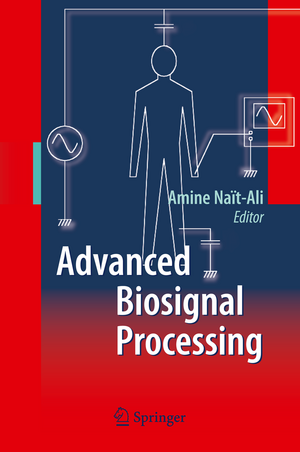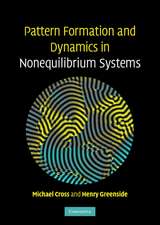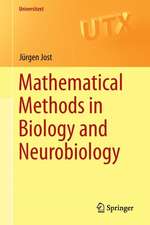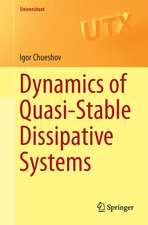Advanced Biosignal Processing
Editat de Amine Nait-Alien Limba Engleză Hardback – 7 apr 2009
| Toate formatele și edițiile | Preț | Express |
|---|---|---|
| Paperback (1) | 1288.99 lei 6-8 săpt. | |
| Springer Berlin, Heidelberg – 19 oct 2010 | 1288.99 lei 6-8 săpt. | |
| Hardback (1) | 1139.45 lei 38-44 zile | |
| Springer Berlin, Heidelberg – 7 apr 2009 | 1139.45 lei 38-44 zile |
Preț: 1139.45 lei
Preț vechi: 1199.43 lei
-5% Nou
Puncte Express: 1709
Preț estimativ în valută:
218.02€ • 227.66$ • 180.04£
218.02€ • 227.66$ • 180.04£
Carte tipărită la comandă
Livrare economică 11-17 aprilie
Preluare comenzi: 021 569.72.76
Specificații
ISBN-13: 9783540895053
ISBN-10: 3540895051
Pagini: 396
Ilustrații: XVI, 378 p. 218 illus., 3 illus. in color.
Dimensiuni: 155 x 235 x 29 mm
Greutate: 0.86 kg
Ediția:2009
Editura: Springer Berlin, Heidelberg
Colecția Springer
Locul publicării:Berlin, Heidelberg, Germany
ISBN-10: 3540895051
Pagini: 396
Ilustrații: XVI, 378 p. 218 illus., 3 illus. in color.
Dimensiuni: 155 x 235 x 29 mm
Greutate: 0.86 kg
Ediția:2009
Editura: Springer Berlin, Heidelberg
Colecția Springer
Locul publicării:Berlin, Heidelberg, Germany
Public țintă
ResearchCuprins
Biosignals: Acquisition and General Properties.- Extraction of ECG Characteristics Using Source Separation Techniques: Exploiting Statistical Independence and Beyond.- ECG Processing for Exercise Test.- Statistical Models Based ECG Classification.- Heart Rate Variability Time-Frequency Analysis for Newborn Seizure Detection.- Adaptive Tracking of EEG Frequency Components.- From EEG Signals to Brain Connectivity: Methods and Applications in Epilepsy.- Neural Network Approaches for EEG Classification.- Analysis of Event-Related Potentials Using Wavelet Networks.- Detection of Evoked Potentials.- Visual Evoked Potential Analysis Using Adaptive Chirplet Transform.- Uterine EMG Analysis: Time-Frequency Based Techniques for Preterm Birth Detection.- Pattern Classification Techniques for EMG Signal Decomposition.- Parametric Modeling of Some Biosignals Using Optimization Metaheuristics.- Nonlinear Analysis of Physiological Time Series.- Biomedical Data Processing Using HHT: A Review.- to Multimodal Compression of Biomedical Data.
Textul de pe ultima copertă
Through 17 chapters, this book presents the principle of many advanced biosignal processing techniques. After an important chapter introducing the main biosignal properties as well as the most recent acquisition techniques, it highlights five specific parts which build the body of this book. Each part concerns one of the most intensively used biosignals in the clinical routine, namely the Electrocardiogram (ECG), the Elektroenzephalogram (EEG), the Electromyogram (EMG) and the Evoked Potential (EP). In addition, each part gathers a certain number of chapters related to analysis, detection, classification, source separation and feature extraction. These aspects are explored by means of various advanced signal processing approaches, namely wavelets, Empirical Modal Decomposition, Neural networks, Markov models, Metaheuristics as well as hybrid approaches including wavelet networks, and neuro-fuzzy networks.
The last part, concerns the Multimodal Biosignal processing, in which we present two different chapters related to the biomedical compression and the data fusion.
Instead organising the chapters by approaches, the present book has been voluntarily structured according to signal categories (ECG, EEG, EMG, EP). This helps the reader, interested in a specific field, to assimilate easily the techniques dedicated to a given class of biosignals. Furthermore, most of signals used for illustration purpose in this book can be downloaded from the Medical Database for the Evaluation of Image and Signal Processing Algorithm. These materials assist considerably the user in evaluating the performances of their developed algorithms.
This book is suited for final year graduate students, engineers and researchers in biomedical engineering and practicing engineers in biomedical science and medical physics.
The last part, concerns the Multimodal Biosignal processing, in which we present two different chapters related to the biomedical compression and the data fusion.
Instead organising the chapters by approaches, the present book has been voluntarily structured according to signal categories (ECG, EEG, EMG, EP). This helps the reader, interested in a specific field, to assimilate easily the techniques dedicated to a given class of biosignals. Furthermore, most of signals used for illustration purpose in this book can be downloaded from the Medical Database for the Evaluation of Image and Signal Processing Algorithm. These materials assist considerably the user in evaluating the performances of their developed algorithms.
This book is suited for final year graduate students, engineers and researchers in biomedical engineering and practicing engineers in biomedical science and medical physics.
Caracteristici
Concise overview of most all standard method Presents latest developments in Biosignal processing











